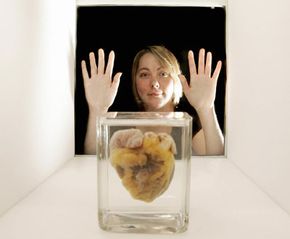Organ Donation Statistics
Let's take a closer look at the different organs that can be donated and examine the organ donation statistics for each one. There are six organs that can be donated and transplanted:
1. Kidney -- The functioning lifespan of a transplanted kidney is about nine years. Of all organs, kidneys are most in demand and the most frequently donated [source: LifeShare]. Most diseases that affect the kidneys affect both at the same time, so a living donor is generally not at a greater health risk with only one kidney.
Advertisement
- Number of people added to list between July 2006 and June 2007: 33,981
- Total number of people on kidney waiting list as of June 2007: 73,850
- Number of deceased-donor transplants between July 2006 and June 2007: 10,571
- Number of living-donor transplants between July 2006 and June 2007: 6,164
- Mortality rate while waiting for kidney: 7 percent [source: SRTR].
2. Liver -- The liver is necessary for vitamin storage, removing waste from blood and digestion.
- Number of people added to list between July 2006 and June 2007: 10,887
- Total number of people on kidney waiting list as of June 2007: 17,142
- Number of deceased-donor transplants between July 2006 and June 2007: 6,274
- Number of living-donor transplants between July 2006 and June 2007: 258
- Mortality rate while waiting for liver: 13 percent [source: SRTR] .
3. Heart -- A heart will beat about 2.5 billion times in the course of an average lifetime. Once removed from the donor's body, a heart can only survive for about four hours.
- Number of people added to list between July 2006 and June 2007: 3,011
- Total number of people on heart waiting list as of June 2007: 2,673
- Number of deceased-donor transplants between July 2006 and June 2007: 2,224
- Mortality rate while waiting for heart: 15 percent [source: SRTR]
4. Lungs -- Single or double-lung transplants can be performed. Additionally, living donors can donate a single lobe from the lungs, though it will not regenerate.
- Number of people added to list between July 2006 and June 2007: 1,886
- Total number of people on lung waiting list as of June 2007: 2,743
- Number of deceased-donor transplants between July 2006 and June 2007: 1,391
- Number of living-donor transplants between July 2006 and June 2007: 4
- Mortality rate while waiting for lung: 12 percent [source: SRTR]
5. Pancreas -- It's possible to make a living donation of a portion of the pancreas and still retain pancreas functionality.
- Number of people added to list between July 2006 and June 2007: 827
- Total number of people on pancreas waiting list as of June 2007: 1,570
- Number of deceased-donor transplants between July 2006 and June 2007: 449
- Mortality rate while waiting for pancreas: 4 percent [source: SRTR].
6. Intestine -- Although quite rare, a living donor can donate a portion of the intestine.
- Number of people added to list between July 2006 and June 2007: 299
- Total number of people on intestine waiting list as of June 2007: 231
- Number of deceased-donor transplants between July 2006 and June 2007): 180
- Mortality rate while waiting for intestine: 22 percent [source: SRTR].
Now that we know more about the organs that can be donated, in the next section we'll see just how recyclable a human body is.
